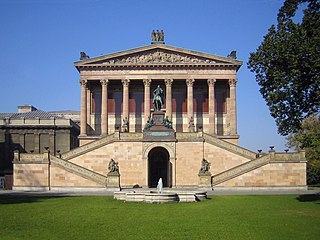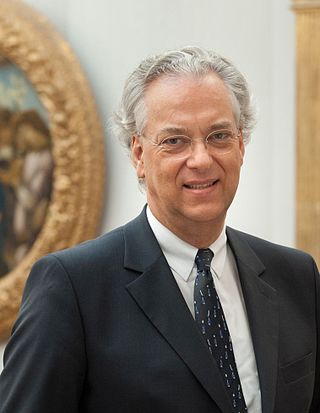| Hunne zu Pferde | |
|---|---|
 The sculpture in 2016 | |
| Artist | Erich Hösel |
| Type | Sculpture |
| Location | Alte Nationalgalerie, Berlin, Germany |
Hunne zu Pferde is a sculpture by Erich Hösel, installed outside the Alte Nationalgalerie in Berlin, Germany. [1]
| Hunne zu Pferde | |
|---|---|
 The sculpture in 2016 | |
| Artist | Erich Hösel |
| Type | Sculpture |
| Location | Alte Nationalgalerie, Berlin, Germany |
Hunne zu Pferde is a sculpture by Erich Hösel, installed outside the Alte Nationalgalerie in Berlin, Germany. [1]

The Egyptian Museum of Berlin is home to one of the world's most important collections of ancient Egyptian artefacts, including the iconic Nefertiti Bust. Since 1855, the collection is a part of the Neues Museum on Berlin's Museum Island, which reopened after renovations in 2009.

The Altes Museum is a listed building on the Museum Island in the historic centre of Berlin, Germany. Built from 1825 to 1830 by order of King Frederick William III of Prussia according to plans by Karl Friedrich Schinkel, it is considered as a major work of German Neoclassical architecture. It is surrounded by the Berlin Cathedral to the east, the Berlin Palace to the south and the Zeughaus to the west. Currently, the Altes Museum is home to the Antikensammlung and parts of the Münzkabinett. As part of the Museum Island complex, the Altes Museum was listed as a UNESCO World Heritage Site in 1999, because of its testimony to the development of museums as a social and architectural phenomenon.

The Alte Nationalgalerie is a listed building on the Museum Island in the historic centre of Berlin, Germany. The gallery was built from 1862 to 1876 by the order of King Frederick William IV of Prussia according to plans by Friedrich August Stüler and Johann Heinrich Strack in Neoclassical and Renaissance Revival styles. The building's outside stair features a memorial to Frederick William IV. Currently, the Alte Nationalgalerie is home to paintings and sculptures of the 19th century and hosts a variety of tourist buses daily. As part of the Museum Island complex, the gallery was inscribed on the UNESCO World Heritage List in 1999 for its outstanding architecture and its testimony to the development of museums and galleries as a cultural phenomenon in the late 19th century.
Nikolaus Geiger was a German sculptor and painter.

The Bode Museum, formerly called the Kaiser-Friedrich-Museum, is a listed building on the Museum Island in the historic centre of Berlin. It was built from 1898 to 1904 by order of German Emperor William II according to plans by Ernst von Ihne in Baroque Revival style. The building's front square featured a memorial to German Emperor Frederick III, which was destroyed by the East German authorities. Currently, the Bode-Museum is home to the Skulpturensammlung, the Museum für Byzantinische Kunst and the Münzkabinett. As part of the Museum Island complex, the Bode-Museum was inscribed on the UNESCO World Heritage List in 1999 because of its outstanding architecture and testimony to the development of museums as a cultural phenomenon in the late 19th and early 20th centuries.

The Staatliche Museen zu Berlin are a group of institutions in Berlin, Germany, comprising seventeen museums in five clusters; several research institutes; libraries; and supporting facilities. They are overseen by the Prussian Cultural Heritage Foundation and funded by the German federal government in collaboration with Germany's federal states. The central complex on Museum Island was added to the UNESCO list of World Heritage Sites in 1999. By 2007, the Staatliche Museen zu Berlin had grown into the largest complex of museums in Europe. The museum was originally founded by King Friedrich Wilhelm III of Prussia in 1823 as the Königliche Museen.
The Pomerania euroregion or Euroregion Pomerania was set up in 1995 as one of the euroregions, thought to connect regions divided between states of the European Union. The name is taken from the region of Pomerania, yet the euroregion is of a different shape than the historical region. It comprises German Western Pomerania and Uckermark, as well as Polish Zachodniopomorskie.

Schloss Köpenick is a Baroque water palace of the Hohenzollern electors of Brandenburg which stands on an island in the Dahme River surrounded by an English-style park and gives its name to Köpenick, a district of Berlin.

The Kunstgewerbemuseum, or Museum of Decorative Arts, is an internationally important museum of the decorative arts in Berlin, Germany, part of the Staatliche Museen zu Berlin. The collection is split between the Kunstgewerbemuseum building at the Kulturforum (52°30′35″N13°22′03″E) and Köpenick Palace (52°26′38″N13°34′22″E).
The Zentralarchiv der Staatlichen Museen zu Berlin is an academic institution in Berlin, Germany, linked with the collections and administrative departments of the Staatliche Museen zu Berlin. It functions as the primary site for research and preservation of the museums' "memory" and their primary source documents. Its holdings span the history of the Staatliche Museen of today back to the former Königliche Museen of the Kingdom of Prussia and German Empire. Through consolidation, the holdings have become one of the most important art history archives in Germany.

Paul Sturm was a German art nouveau sculptor, medallist and designer.

The Museum of Islamic Art is located in the Pergamon Museum and is part of the Staatliche Museen zu Berlin.

The equestrian statue of Frederick William IV is an 1875–86 sculpture of Frederick William IV of Prussia by Alexander Calandrelli, installed in front of the Alte Nationalgalerie in Berlin, Germany.

The Monument is a 2015 sculpture by Atelier Van Lieshout. It is part of the collection of Alte Nationalgalerie in Berlin, Germany.

Hercules and the Nemean Lion is a sculpture of Hercules fighting the Nemean lion by Max Klein, installed in the Kolonnadenhof outside the Alte Nationalgalerie in Berlin, Germany.

Michael Eissenhauer is a German art historian and was director-general of the Staatliche Museen zu Berlin.
Tina Haim-Wentscher also: Tina Haim-Wentcher was a German-Australian sculptor.

Dahlem Museums is a complex in the Berlin-Dahlem district of Berlin. Its official address is at 8 Lansstraße, though its main entrance is at 25 Arnimallee. The earliest planning for the building was between 1914 and 1923, thanks to the efforts of Wilhelm von Bode and to designs by Bruno Paul. However, it was only eventually built between 1969 and 1973 to New Objectivity plans by Fritz Bornemann and Wils Ebert.